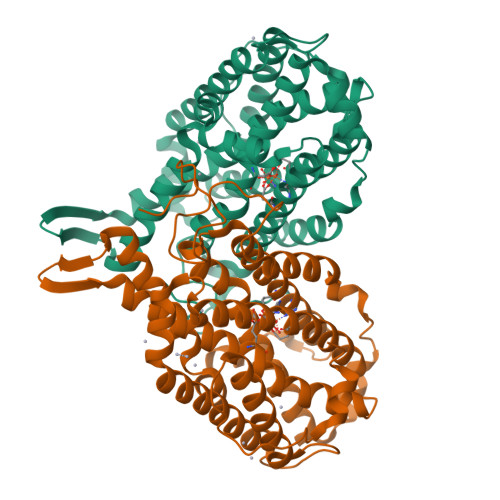A new tyrosyl radical on Phe208 as ligand to the diiron center in Escherichia coli ribonucleotide reductase, mutant R2-Y122H. Combined x-ray diffraction and EPR/ENDOR studies
Kolberg, M., Logan, D.T., Bleifuss, G., Poetsch, S., Sjoeberg, B.M., Graeslund, A., Lubitz, W., Lassmann, G., Lendzian, F.(2005) J Biological Chem 280: 11233-11246
- PubMed: 15634667
- DOI: https://doi.org/10.1074/jbc.M414634200
- Primary Citation of Related Structures:
1YFD - PubMed Abstract:
The R2 protein subunit of class I ribonucleotide reductase (RNR) belongs to a structurally related family of oxygen bridged diiron proteins. In wild-type R2 of Escherichia coli, reductive cleavage of molecular oxygen by the diferrous iron center generates a radical on a nearby tyrosine residue (Tyr122), which is essential for the enzymatic activity of RNR, converting ribonucleotides into deoxyribonucleotides. In this work, we characterize the mutant E. coli protein R2-Y122H, where the radical site is substituted with a histidine residue. The x-ray structure verifies the mutation. R2-Y122H contains a novel stable paramagnetic center which we name H, and which we have previously proposed to be a diferric iron center with a strongly coupled radical, Fe(III)Fe(III)R.. Here we report a detailed characterization of center H, using 1H/2H -14N/15N- and 57Fe-ENDOR in comparison with the Fe(III)Fe(IV) intermediate X observed in the iron reconstitution reaction of R2. Specific deuterium labeling of phenylalanine residues reveals that the radical results from a phenylalanine. As Phe208 is the only phenylalanine in the ligand sphere of the iron site, and generation of a phenyl radical requires a very high oxidation potential, we propose that in Y122H residue Phe208 is hydroxylated, as observed earlier in another mutant (R2-Y122F/E238A), and further oxidized to a phenoxyl radical, which is coordinated to Fe1. This work demonstrates that small structural changes can redirect the reactivity of the diiron site, leading to oxygenation of a hydrocarbon, as observed in the structurally similar methane monoxygenase, and beyond, to formation of a stable iron-coordinated radical.
Organizational Affiliation:
Max-Volmer-Laboratory, Institute for Chemistry, PC 14, Technical University Berlin, D-10623 Berlin, Germany.


















